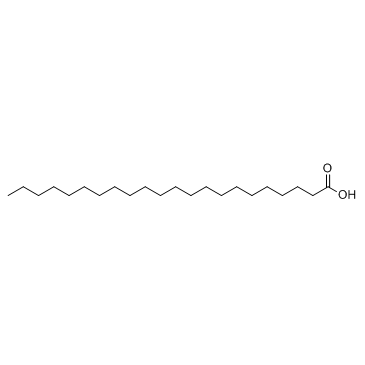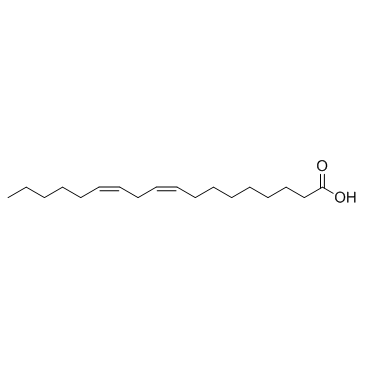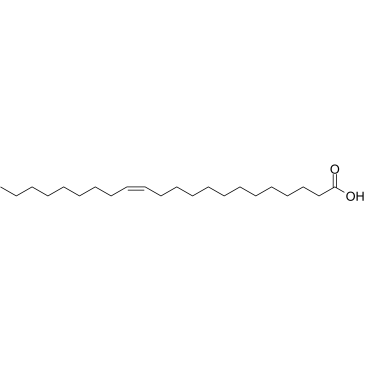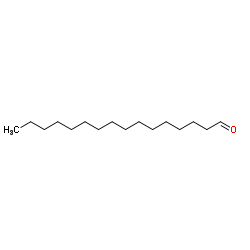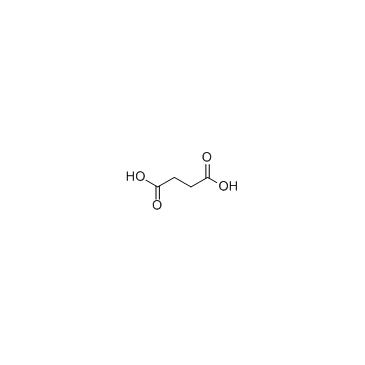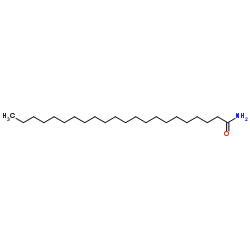112-85-6
| 中文名 | 二十二酸 |
|---|---|
| 英文名 | behenic acid |
| 中文别名 |
山俞酸
二十二烷酸 扁油酸 山萮酸 蘿酸 山嵛酸 |
| 英文别名 |
Docosanoic acid
docosanic acid n-docosanoic acid MFCD00002807 Hydrofol 2022-55 behenic acid Glycon B-70 Hydrofol Acid 560 EINECS 204-010-8 Docosoic acid |
| 描述 | Docosanoic acid 是一种较难吸收的,能提高人类胆固醇水平的饱和脂肪酸。 |
|---|---|
| 相关类别 | |
| 靶点 |
Human Endogenous Metabolite |
| 参考文献 |
| 密度 | 0.9±0.1 g/cm3 |
|---|---|
| 沸点 | 391.8±5.0 °C at 760 mmHg |
| 熔点 | 72-80 °C(lit.) |
| 分子式 | C22H44O2 |
| 分子量 | 340.584 |
| 闪点 | 176.3±12.5 °C |
| 精确质量 | 340.334137 |
| PSA | 37.30000 |
| LogP | 10.34 |
| 外观性状 | 白色至奶油色晶体或粉末 |
| 蒸汽压 | 0.0±0.9 mmHg at 25°C |
| 折射率 | 1.459 |
| 储存条件 | 1.储存于阴凉、干燥、通风良好的库房。远离火种、热源。防止阳光直射。包装必须密封,切勿受潮。应与氧化剂、还原剂、强碱分开存放,切忌混储。 2.配备相应品种和数量的消防器材。储区应备有泄漏应急处理设备和合适的收容材料。 |
| 稳定性 | 1. 避免与氧化剂、还原剂、碱接触。 2. 存在于烤烟烟叶中、白肋烟烟叶中。 |
| 水溶解性 | 水溶性:实际上不溶;极微溶:乙醚,乙醇 |
| 分子结构 | 五、分子性质数据: 1、 摩尔折射率:105.53 2、 摩尔体积(cm3/mol):386.3 3、 等张比容(90.2K):929.2 4、 表面张力(dyne/cm):33.4 5、 极化率(10-24cm3):41.83 |
| 计算化学 | 1、 疏水参数计算参考值(XlogP):9.6 2、 氢键供体数量:1 3、 氢键受体数量:2 4、 可旋转化学键数量:20 5、 互变异构体数量: 6、 拓扑分子极性表面积(TPSA):37.3 7、 重原子数量:24 8、 表面电荷:0 9、 复杂度:250 10、 同位素原子数量:0 11、 确定原子立构中心数量:0 12、 不确定原子立构中心数量:0 13、 确定化学键立构中心数量:0 14、 不确定化学键立构中心数量:0 15、 共价键单元数量:1 |
| 更多 | 1. 性状:气味柔和的固体。 2. 密度(g/mL,20℃):0.8221 3. 沸点(ºC):306(7998pa) 4. 熔点(ºC):80~81 5. 相对密度(20℃,4℃):0.822390 6. 沸点(ºC,8.0KPa):306 7. 折射率(n100D):1.4270 8. 闪点(ºC):176.3 9.相对密度(25℃,4℃):0.821995 10. 常温折射率(n25):1.4270100 11. 蒸气压(mmHg,ºC): 12. 饱和蒸气压(kPa, ºC):未确定 13. 燃烧热(KJ/mol):未确定 14. 临界温度(ºC):未确定 15. 临界压力(KPa):未确定 16. 油水(辛醇/水)分配系数的对数值:未确定 17. 爆炸上限(%,V/V):未确定 18. 爆炸下限(%,V/V):未确定 19. 溶解性:溶于氯仿,微溶于水、乙醇和乙醚。 |
Synonym:Behenic Acid Section 2 - COMPOSITION, INFORMATION ON INGREDIENTS
Risk Phrases: None Listed. Section 3 - HAZARDS IDENTIFICATION EMERGENCY OVERVIEW
The toxicological properties of this material have not been fully investigated. Potential Health Effects Eye: May cause eye irritation. Skin: May cause skin irritation. Ingestion: May cause irritation of the digestive tract. The toxicological properties of this substance have not been fully investigated. Inhalation: May cause respiratory tract irritation. The toxicological properties of this substance have not been fully investigated. Chronic: No information found. Section 4 - FIRST AID MEASURES Eyes: Flush eyes with plenty of water for at least 15 minutes, occasionally lifting the upper and lower eyelids. Get medical aid. Skin: Get medical aid. Flush skin with plenty of water for at least 15 minutes while removing contaminated clothing and shoes. Wash clothing before reuse. Ingestion: Never give anything by mouth to an unconscious person. Get medical aid. Do NOT induce vomiting. If conscious and alert, rinse mouth and drink 2-4 cupfuls of milk or water. Inhalation: Remove from exposure and move to fresh air immediately. If not breathing, give artificial respiration. If breathing is difficult, give oxygen. Get medical aid. Notes to Physician: Section 5 - FIRE FIGHTING MEASURES General Information: As in any fire, wear a self-contained breathing apparatus in pressure-demand, MSHA/NIOSH (approved or equivalent), and full protective gear. During a fire, irritating and highly toxic gases may be generated by thermal decomposition or combustion. Extinguishing Media: Use agent most appropriate to extinguish fire. Use water spray, dry chemical, carbon dioxide, or appropriate foam. Section 6 - ACCIDENTAL RELEASE MEASURES General Information: Use proper personal protective equipment as indicated in Section 8. Spills/Leaks: Clean up spills immediately, observing precautions in the Protective Equipment section. Sweep up, then place into a suitable container for disposal. Avoid generating dusty conditions. Provide ventilation. Section 7 - HANDLING and STORAGE Handling: Wash thoroughly after handling. Remove contaminated clothing and wash before reuse. Use with adequate ventilation. Minimize dust generation and accumulation. Avoid contact with eyes, skin, and clothing. Keep container tightly closed. Avoid ingestion and inhalation. Storage: Store in a tightly closed container. Store in a cool, dry, well-ventilated area away from incompatible substances. Section 8 - EXPOSURE CONTROLS, PERSONAL PROTECTION Engineering Controls: Facilities storing or utilizing this material should be equipped with an eyewash facility and a safety shower. Use adequate ventilation to keep airborne concentrations low. Exposure Limits CAS# 112-85-6: Personal Protective Equipment Eyes: Wear appropriate protective eyeglasses or chemical safety goggles as described by OSHA's eye and face protection regulations in 29 CFR 1910.133 or European Standard EN166. Skin: Wear appropriate protective gloves to prevent skin exposure. Clothing: Wear appropriate protective clothing to prevent skin exposure. Respirators: A respiratory protection program that meets OSHA's 29 CFR 1910.134 and ANSI Z88.2 requirements or European Standard EN 149 must be followed whenever workplace conditions warrant respirator use. Section 9 - PHYSICAL AND CHEMICAL PROPERTIES Physical State: Powder Color: white Odor: None reported. pH: Not available. Vapor Pressure: Not available. Viscosity: Not available. Boiling Point: 306 deg C @ 60.00mmHg Freezing/Melting Point: 80.00 - 82.00 deg C Autoignition Temperature: Not applicable. Flash Point: Not applicable. Explosion Limits, lower: Not available. Explosion Limits, upper: Not available. Decomposition Temperature: Solubility in water: Specific Gravity/Density: Molecular Formula: C22H44O2 Molecular Weight: 340.58 Section 10 - STABILITY AND REACTIVITY Chemical Stability: Stable under normal temperatures and pressures. Conditions to Avoid: Incompatible materials, dust generation, excess heat, strong oxidants. Incompatibilities with Other Materials: Oxidizing agents. Hazardous Decomposition Products: Carbon monoxide, irritating and toxic fumes and gases, carbon dioxide. Hazardous Polymerization: Has not been reported. Section 11 - TOXICOLOGICAL INFORMATION RTECS#: CAS# 112-85-6 unlisted. LD50/LC50: Not available. Carcinogenicity: Docosanoic Acid - Not listed by ACGIH, IARC, or NTP. Section 12 - ECOLOGICAL INFORMATION Section 13 - DISPOSAL CONSIDERATIONS Dispose of in a manner consistent with federal, state, and local regulations. Section 14 - TRANSPORT INFORMATION IATA No information available. IMO No information available. RID/ADR No information available. Section 15 - REGULATORY INFORMATION European/International Regulations European Labeling in Accordance with EC Directives Hazard Symbols: Not available. Risk Phrases: Safety Phrases: S 24/25 Avoid contact with skin and eyes. S 28A After contact with skin, wash immediately with plenty of water. S 37 Wear suitable gloves. S 45 In case of accident or if you feel unwell, seek medical advice immediately (show the label where possible). WGK (Water Danger/Protection) CAS# 112-85-6: 0 Canada CAS# 112-85-6 is listed on Canada's DSL List. CAS# 112-85-6 is not listed on Canada's Ingredient Disclosure List. US FEDERAL TSCA CAS# 112-85-6 is listed on the TSCA inventory. SECTION 16 - ADDITIONAL INFORMATION N/A |
|
生态学数据: 对水有轻微的危害。
|
| 个人防护装备 | Eyeshields;Gloves;type N95 (US);type P1 (EN143) respirator filter |
|---|---|
| 危害码 (欧洲) | Xi |
| 风险声明 (欧洲) | R36/37/38 |
| 安全声明 (欧洲) | S26-S36/37/39-S24/25 |
| 危险品运输编码 | NONH for all modes of transport |
| WGK德国 | - |
| 包装等级 | II |
| 危险类别 | 6.1 |
| 海关编码 | 2915900090 |
| 上游产品 8 | |
|---|---|
| 下游产品 9 | |
| 海关编码 | 2915900090 |
|---|---|
| 中文概述 | 2915900090. 其他饱和无环一元羧酸及其酸酐(酰卤、过氧)化物、过氧酸及其卤化、硝化、磺化、亚硝化衍生物. 增值税率:17.0%. 退税率:9.0%. 监管条件:AB(入境货物通关单,出境货物通关单). 最惠国关税:5.5%. 普通关税:30.0% |
| 申报要素 | 品名, 成分含量, 用途 |
| 监管条件 | A.入境货物通关单 B.出境货物通关单 |
| 检验检疫 | R.进口食品卫生监督检验 S.出口食品卫生监督检验 M.进口商品检验 N.出口商品检验 |
| Summary | 2915900090 other saturated acyclic monocarboxylic acids and their anhydrides, halides, peroxides and peroxyacids; their halogenated, sulphonated, nitrated or nitrosated derivatives VAT:17.0% Tax rebate rate:9.0% Supervision conditions:AB(certificate of inspection for goods inward,certificate of inspection for goods outward) MFN tariff:5.5% General tariff:30.0% |


